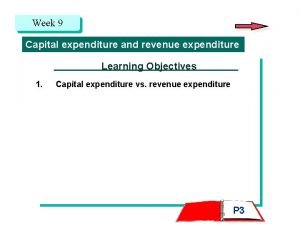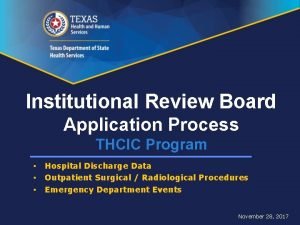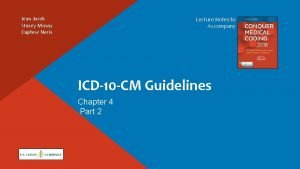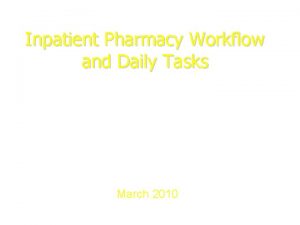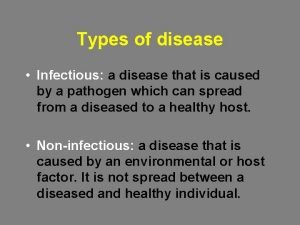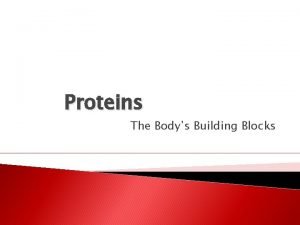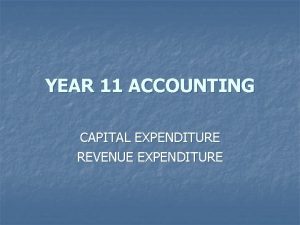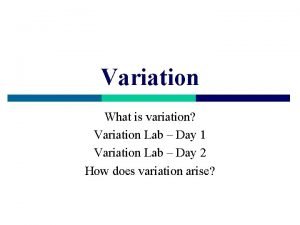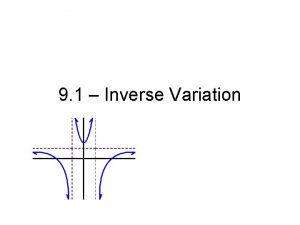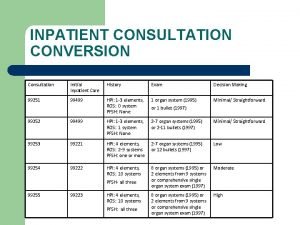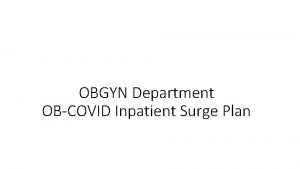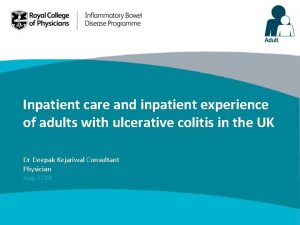Variation of inpatient expenditure rates High expenditure diseases




















- Slides: 20

Variation of inpatient expenditure rates High expenditure diseases and interventions

Cancer 2

Cancer – Inpatient expenditure rate, 2008/9 (weighted for age, sex and need - per 1, 000 population). Source: DH CAI (using HES) There is a 2 -fold variation in expenditure between PCTs (adjusting for age, sex and need). The coefficient of variation is 14. 1%. (This takes into account all PCTs, not just the top and bottom PCTs. ) The potential savings are £ 100 M (if PCTs with rates higher than the median reduced to this level). London 3

Circulation 4

Circulatory diseases – Inpatient expenditure rate, 2008/9 (weighted for age, sex and need - per 1, 000 population). Source: DH CAI (using HES) There is a 3 -fold variation in expenditure between PCTs (adjusting for age, sex and need). The coefficient of variation is 17. 6%. (This takes into account all PCTs, not just the top and bottom PCTs. ) The potential savings are £ 138 M (if PCTs with rates higher than the median reduced to this level). London 5

Cardiac valve procedures – Inpatient expenditure rate, 2008/9 (weighted for age, sex and need - per 1, 000 population). Source: DH CAI (using HES) Cardiac valve procedures cost £ 12, 343 each. Small drops in activity give large savings There is a 5 -fold variation in expenditure between PCTs (adjusting for age, sex and need). The coefficient of variation is 26. 5%. (This takes into account all PCTs, not just the top and bottom PCTs. ) London Some The potential savings are £ 19 M overlap (if PCTs with rates higher than the median reduced to this level). with Relatively high unwarranted circulatory variation so large potential savings. 96% of expenditure in analysis 6

Percutaneous coronary intervention – Inpatient expenditure rate, 2008/9 (weighted for age, sex and need - per 1, 000 population). Source: DH CAI (using HES) Percutaneous coronary interventions cost £ 4, 582 each. There is a 4 -fold variation in expenditure between PCTs (adjusting for age, sex and need). The coefficient of variation is 29. 5%. (This takes into account all PCTs, not just the top and bottom PCTs. ) The potential savings are £ 32 M (if PCTs with rates higher than the median reduced to this level). London Relatively high unwarranted variation so large potential savings. 7

Cardiac catheterisation and angiography – Inpatient expenditure rate, 2008/9 (weighted for age, sex and need - per 1, 000 population). Source: DH CAI (using HES) Cardiac catheterisation and angiography without complications cost £ 1, 901 each. There is a 5 -fold variation in expenditure between PCTs (adjusting for age, sex and need). The coefficient of variation is 29. 9%. (This takes into account all PCTs, not just the top and bottom PCTs. ) The potential savings are £ 28 M London (if PCTs with rates higher than the median reduced to this level). 8

Coronary bypass – Inpatient expenditure rate, 2008/9 (weighted for age, sex and need - per 1, 000 population). Source: DH CAI (using HES) Coronary bypasses cost £ 8, 660 each. There is a 9 -fold variation in expenditure between PCTs (adjusting for age, sex and need). The coefficient of variation is 27. 3%. (This takes into account all PCTs, not just the top and bottom PCTs. ) The potential savings are £ 14 M (if PCTs with rates higher than the median reduced to this level). London 9

Non-transient stroke or cerebrovascular accident >69 Inpatient expenditure rate, 2008/9 (weighted for age, sex and need - per 1, 000 population). Source: DH CAI (using HES) Non-transient stroke or cerebrovascular accidents >69 cost £ 4, 096 each. There is a 5 -fold variation in expenditure between PCTs (adjusting for age, sex and need). The coefficient of variation is 18. 7%. (This takes into account all PCTs, not just the top and bottom PCTs. ) The potential savings are £ 14 M London (if PCTs with rates higher than the median reduced to this level). 10

Musculoskeletal 11

Musculoskeletal problems – Inpatient expenditure rate, 2008/9 (weighted for age, sex and need - per 1, 000 population). Source: DH CAI (using HES) We are working on disease specific additional needs, which will even better adjust rates across the country Much variation is also above the median, so leads to large potential savings There is a 3 -fold variation in expenditure between PCTs (adjusting for age, sex and need). The coefficient of variation is 20. 3%. (This takes into account all PCTs, not just the top and bottom PCTs. ) The potential savings are £ 163 M (if PCTs with rates higher than the median reduced to this level). London 12

Primary knee replacements – Inpatient expenditure rate, 2008/9 (weighted for age, sex and need - per 1, 000 population). Source: DH CAI (using HES) Primary knee replacements cost £ 5, 806 each. There is a 4 -fold variation in expenditure between PCTs (adjusting for age, sex and need). The coefficient of variation is 20. 6%. (This takes into account all PCTs, not just the top and bottom PCTs. ) The potential savings are £ 38 M (if PCTs with rates higher than the median reduced to this level). London 13

Primary Hip Replacement Cemented – Inpatient expenditure rate, 2008/9 (weighted for age, sex and need - per 1, 000 population). Source: DH CAI (using HES) Extremely large variation between PCTs. Primary hip replacemented cost £ 5, 467 each. There is a 15 -fold variation in expenditure between PCTs (adjusting for age, sex and need). The coefficient of variation is 39. 9%. (This takes into account all PCTs, not just the top and bottom PCTs. ) The potential savings are £ 41 M London (if PCTs with rates higher than the median reduced to this level). Relatively large unwarranted variation so large potential savings 14

Complex Elderly with a Musculoskeletal System Primary Diagnosis Inpatient expenditure rate, 2008/9 (weighted for age, sex and need - per 1, 000 population). Source: DH CAI (using HES) Complex elderly with a musculoskeletal system primary diagnosis cost £ 6, 927 each. There is a 3 -fold variation in expenditure between PCTs (adjusting for age, sex and need). The coefficient of variation is 21. 3% (This takes into account all PCTs, not just the top and bottom PCTs. ) The potential savings are £ 21 M London (if PCTs with rates higher than the median reduced to this level). 15

Respiratory 16

Respiratory diseases – Inpatient expenditure rate, 2008/9 (weighted for age, sex and need - per 1, 000 population). Source: DH CAI (using HES) Accounting for additional needs explains much variation between PCTs There is a 2 -fold variation in expenditure between PCTs (adjusting for age, sex and need). The coefficient of variation is 11. 4%. (This takes into account all PCTs, not just the top and bottom PCTs. ) The potential savings are £ 57 M London (if PCTs with rates higher than the median reduced to this level). Relatively little unwarranted variation so small potential savings 17

Complex Elderly with a Respiratory System Primary Diagnosis Inpatient expenditure rate, 2008/9 (weighted for age, sex and need - per 1, 000 population). Source: DH CAI (using HES) Complex elderly with a respiratory system primary diagnosis cost £ 3, 165 each. There is a 4 -fold variation in expenditure between PCTs (adjusting for age, sex and need). The coefficient of variation is 24. 2% (This takes into account all PCTs, not just the top and bottom PCTs. ) The potential savings are £ 20 M London (if PCTs with rates higher than the median reduced to this level). 18

Interventions not in above categories 19

Complex Elderly with a Nervous System Primary Diagnosis Inpatient expenditure rate, 2008/9 (weighted for age, sex and need - per 1, 000 population). Source: DH CAI (using HES) Complex elderly with a nervous system primary diagnosis cost £ 5, 401 each. There is a 4 -fold variation in expenditure between PCTs (adjusting for age, sex and need). The coefficient of variation is 23. 6% (This takes into account all PCTs, not just the top and bottom PCTs. ) The potential savings are £ 15 M London (if PCTs with rates higher than the median reduced to this level). 20
 Capital and revenue expenditure
Capital and revenue expenditure Examples of revenue and capital expenditure
Examples of revenue and capital expenditure Revenue expenditure examples
Revenue expenditure examples Deferred revenue expenditure
Deferred revenue expenditure Miracles wichita kansas
Miracles wichita kansas Inpatient in nh
Inpatient in nh Thcic inpatient data
Thcic inpatient data Poa indicators are assigned in the inpatient setting for
Poa indicators are assigned in the inpatient setting for Inpatient pharmacy workflow
Inpatient pharmacy workflow What is a unit ratio
What is a unit ratio Equivalent ratios
Equivalent ratios Ratios rates and unit rates
Ratios rates and unit rates Ratios rates and unit rates
Ratios rates and unit rates Constant of variation
Constant of variation Inverse eq
Inverse eq Coefficient of determination formula in regression
Coefficient of determination formula in regression Financial risk definition
Financial risk definition Types of diseases
Types of diseases Quality guru
Quality guru Protein deficiency diseases
Protein deficiency diseases Natural disease
Natural disease
